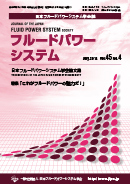All issues

Volume 45 (2014)
- Issue 6 Pages 85-
- Issue 5 Pages 73-
- Issue 4 Pages 51-
- Issue 3 Pages 29-
- Issue 2 Pages 15-
- Issue 1 Pages 1-
Volume 45, Issue 4
Displaying 1-3 of 3 articles from this issue
- |<
- <
- 1
- >
- >|
Paper
-
(Design and Fabrication for Improvement of Suction Force and Simplification for Disposable Structure)Hiroyuki MIYAMOTO, Toshio TAKAYAMA, Toru OMATA, Hiroyuki OHIZUMI2014 Volume 45 Issue 4 Pages 51-57
Published: 2014
Released on J-STAGE: August 05, 2015
JOURNAL FREE ACCESSIn thoracoscopic surgery for lung cancer, surgeons manipulate the lobe of lung to proper positions to approach to surgical sites. However, the tissue might be damaged while it is picked up with a conventional thin shaped forceps. To overcome the problem, a transformable lung positioner that can be inserted from a 12 mm port was previously developed. The device has three links, each of which has suction cups for adhesion. It is transformed from a linear shape into a triangle, which allows wider area. Requirements for the positioner are as follows. It can lift up more than 500 g, which is heavier than the average weight of a human lung 445 g. Such a device must be disposable for clinical use because the tissue or blood might be sucked up into the device. Therefore the structure should be simple. The suction force of the previous positioner was insufficient and its structure was too complicated. Therefore this study redesigns the structure of the flow path and develops components for the positioner applying silicone rubber and plastics for the materials of the device. Their intrinsic flexibility and bio-compatibility are advantageous. The components were fabricated and assembled into the new positioner. To increase the suction force, we also developed bellows shaped suction cups that can fit to a soft tissue. The new positioner can lift up porcine liver weighed 510 g.View full abstractDownload PDF (1700K) -
Yoshiharu INAGUMA2014 Volume 45 Issue 4 Pages 58-65
Published: 2014
Released on J-STAGE: August 05, 2015
JOURNAL FREE ACCESSThis article describes the friction characteristics at a vane tip, which causes primary loss of torque in a balanced vane pump, through the measurement of the coefficient of friction at the vane tip using cylindrical test rings having various values of inner surface roughness. Especially, the influence of operating conditions such as operating pressures, rotational speeds and oil temperature on the friction characteristics is experimentally investigated. Under the situation that the coefficient of friction becomes lower by lessening the surface roughness in the region of less than 0.7 µmRz, the coefficient of friction increases with an increase in the pressure acting on the vane in this region. However, both a rise in oil temperature and a decrease in the rotational speed (the vane sliding speed) make the coefficient of friction higher independently of the surface roughness. In addition, a mathematical model for the friction characteristics at the vane tip under a fixed pressure condition is proposed by using the sliding speed of the vane and the oil temperature instead of the viscosity of oil as parameters. It can well simulate the relationship between the coefficient of friction and the operating conditions for each ring with a different value of the surface roughness.View full abstractDownload PDF (2364K) -
(3rd report) Appling new Posicast Control to production DowncoilerHiroaki KUWANO2014 Volume 45 Issue 4 Pages 66-72
Published: 2014
Released on J-STAGE: August 05, 2015
JOURNAL FREE ACCESSMany kinds of electro-hydraulic servo systems are applied to rolling mills such as a hot strip mill, a cold strip mill and a seamless tube mill because their quick response, high power and high positioning accuracy. However when applying such a system to a hot strip downcoiler, it was found that the controlled object has low natural frequency and is lightly damped so that stable control is very difficult. In the first report, Optimal control theory was applied, however, the derived control system was shown to be poor in robustness. Especially, the control effectiveness was highly influenced by the response of the servo valve and the length of piping between the servo valve and the cylinder. In the second report, in order to overcome this difficulty, a novel and practical control method was proposed and developed based on the Posicast Control proposed by O.J.M. Smith in 1957, which can make the system stable and give a high response. In this report, the practical design method of the proposed control system named new Posicast control is described, and it will be shown that this new Posicast control system realizes a kind of dead-beat control and gives high response and robust stable control by using the internal information of the controlled object. The effectiveness of the proposed control system is also shown by using the data of a downcoiler operated in a production line.View full abstractDownload PDF (2182K)
- |<
- <
- 1
- >
- >|